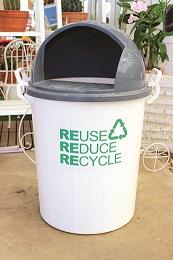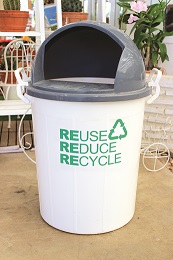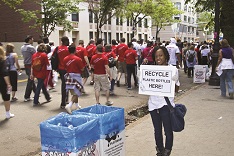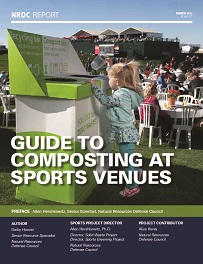
 With all the buzz on sustainability, reducing, recycling, reusing, eco-friendly this and eco-conscious that, it can seem overwhelming. However, being “green” doesn’t have to be difficult. It starts with taking small steps at home, at work and at events. From reducing the amount of waste that ends up in the landfill to something as simple as walking to an event instead of driving, you can incorporate eco-friendly actions into your daily regimen. But what about sporting events? How does one go from turning their personal actions into actions that could potentially affect thousands of people?
With all the buzz on sustainability, reducing, recycling, reusing, eco-friendly this and eco-conscious that, it can seem overwhelming. However, being “green” doesn’t have to be difficult. It starts with taking small steps at home, at work and at events. From reducing the amount of waste that ends up in the landfill to something as simple as walking to an event instead of driving, you can incorporate eco-friendly actions into your daily regimen. But what about sporting events? How does one go from turning their personal actions into actions that could potentially affect thousands of people?
Set Goals for Your Event
Any element of a sporting event (regardless of its size or type of sport) requires planning ahead to ensure that things run smoothly, whether it’s how you plan to promote the event or in this case, how to make an event more sustainable. Start by writing a list of specific goals and objectives (even if it’s just a couple to get you started), along with how you plan to achieve them and how you will measure their success.
“Hosting a sustainable event” is not specific enough, and leaves nothing to measure. What will you do to make it sustainable? Reduce the amount of food waste at the event (and measure it by pounds of food that will be composted or given to a local food bank)? Provide the media with information on jump drives instead of printed materials (and count the number of pages that each jump drive replaced)? Be detailed with your goals, as each one is an important contributor to the big picture.
 One example of a goal would be to cut down on the number of individual cars needed to get to the event (by instead encouraging people to arrive by public or alternative transportation). This goal could be achieved by offering options such as free bus passes or bicycle valet parking. It would be possible to measure the success of these actions and to judge how many fewer cars were used; two indicators, for example, would include calculating how many bus passes were being redeemed and how many people were using the valet to park their bike.
One example of a goal would be to cut down on the number of individual cars needed to get to the event (by instead encouraging people to arrive by public or alternative transportation). This goal could be achieved by offering options such as free bus passes or bicycle valet parking. It would be possible to measure the success of these actions and to judge how many fewer cars were used; two indicators, for example, would include calculating how many bus passes were being redeemed and how many people were using the valet to park their bike.
Remember the Impact of Food
Food is an essential part of any event, particularly at sporting events, as it keeps the athletes fueled for participation and the spectators satisfied. Because of the necessity of food at gatherings, the amount of food waste created is staggering. Food waste makes up the majority of materials found in municipal solid waste landfills and incinerators, which is really the last place it belongs. Besides adding more unnecessary material to the landfills, decomposing food waste causes methane gas emissions (methane is a powerful greenhouse gas), and when combusted, also causes emissions of NOx (which contribute to smog, acid rain, and tropospheric ozone - another greenhouse gas).
The Natural Resources Defense Council’s recent Guide to Composting at Sports Venues report says that in 2011 alone, more than 36 million tons of food waste was generated. Only a small percentage of this waste (four percent, or roughly 1.4 million tons) was kept out of the landfills or incinerators through composting. Composting is collecting food scraps, yard waste, and now even certain utensils and dinnerware and breaking down these organic matters into a new, nutrient-rich product that can be used as fertilizer. Not only do you reduce the amount of waste going into landfills (and the amount of greenhouse gasses coming out), but you reduce the need for fertilizers made by fossil fuels (since compost is naturally made) while making the soil healthier and more fertile overall (as the soil structure is improved and the nutrient content is increased). Composting is nature’s way of recycling, and benefits soil and our food in the long run.

Many sports teams at all levels of competition have turned to composting as a way to reduce food waste with great success. The Seattle Mariners game-day waste diversion was at 38 percent in 2009. Five years later, it’s at 90 percent, thanks to a thorough composting and recycling program, the use of compostable servicewear and packaging, and improved stations for discarding waste (only 17 garbage cans are used in the entire stadium!). Besides the environmental benefits, these actions are saving Safeco Field $100,000 per year.
But you don’t have to be a professional team with a massive budget to make a difference. The Emerald City Roller Girls (Eugene, Oregon’s, non-profit roller derby association) has been recognized and awarded for their efforts toward zero-waste events. Eco-friendly and compostable food containers and flatware are the standard, along with recycling and compost stations staffed by friendly certified Master Recyclers to help educate the public on how to discard items and minimize the amount of waste.
 Why Take Steps Towards a Greener Event?
Why Take Steps Towards a Greener Event?
We’ve explored a few ways that hosting a “green” event can help the environment, whether it’s reducing the amount of waste that ends up in landfills to reducing the amount of greenhouse gases released in the atmosphere. These alone are great reasons to improve the impact of an event, but there are other benefits that should be considered.
For example, there may be potential economic benefits with reduced hauling fees for organizations and events as they divert waste away from landfills. Or consider that the positive impression of sustainable practices at an event can also have a positive overall impression on your event. In general, the media approves of, and will publicize, measures that are taken to minimize the environmental impact of events (especially when thousands of people gather in one place), so taking responsibility and going above and beyond with eco-friendly initiatives can only generate favorable press on your behalf.
Volunteers may also be willing to lend a hand to see an event success (and these people could become extra ambassadors). As your event may gain newfound attention, it may also result in an increased number of participants or even new sponsors that are eager to support your cause. There is also the benefit of being viewed as a leader or innovator, as you explore new ways to improve your event’s impact.
Be creative with your approaches, and seek support and ideas from the local sports commission or CVB as well as others (not-so-local) that have been successful with their green approaches. One example is the Eugene, Cascades & Coast Sports Commission which offers a free download of the Responsible Sports Events 1-2-3 guide. This guide (in partnership with the Council for Responsible Sports) is designed to help event organizers increase an event’s social impact while reducing the environmental footprint.
Ask for help and suggestions as you create the goals and plans for your sustainable events, and offer your knowledge to those looking to improve their practices. By being proactive with the actions you take, you may inspire others to make a difference, one event at a time.

